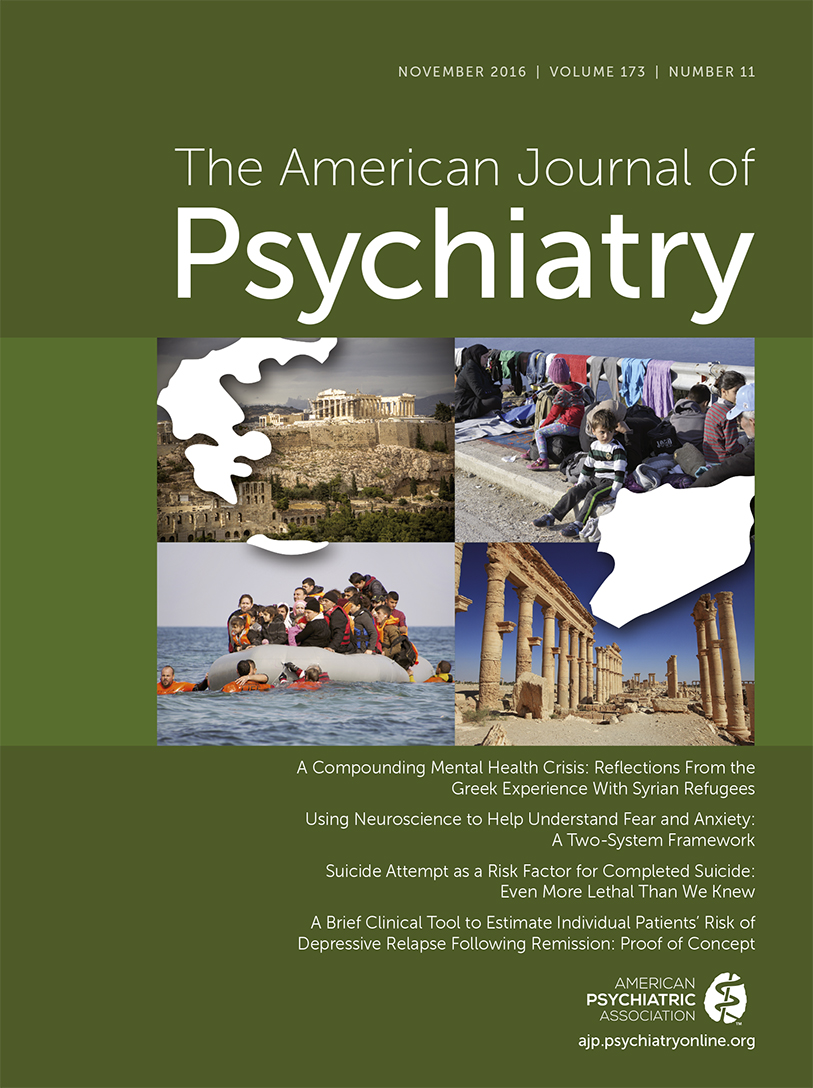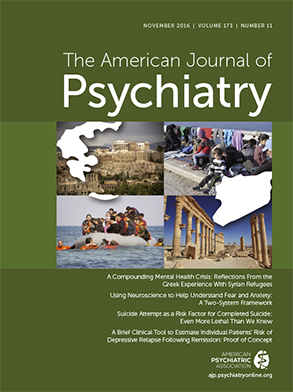Disruptive behavior disorder comprises conduct disorder, defined as the persistent violation of the rights of others and of age-appropriate norms, and oppositional defiant disorder, characterized by angry or irritable mood, argumentative or defiant behavior, or vindictiveness. Conduct disorder and oppositional defiant disorder are two of the most prevalent child psychiatric disorders. They confer considerable costs to society and are associated with relatively poor long-term prognoses. The meta-analytic review published in this issue (
1) summarizes the findings of 24 functional magnetic resonance imaging (fMRI) studies of patients with these disorders and provides useful information regarding the pathophysiology of the disorders. The authors conducted several meta-analyses of these studies: one omnibus analysis contrasting youths with disruptive behavior disorder or conduct problems across all tasks and then several sub-meta-analyses that examined group differences on tasks grouped according to whether they involved “hot” executive functioning, “cool” executive functioning, or emotion processing. Core findings of the omnibus meta-analysis are that, across tasks, youths with disruptive behavior disorder or conduct problems showed underactivation in the rostral and dorsal anterior cingulate and in the medial prefrontal cortex and ventral caudate. However, the sub-meta-analyses revealed that these results were primarily driven by the hot executive function fMRI studies. It is perhaps worth considering here what hot executive functioning is. As the authors point out, previous work has distinguished between hot and cool executive functions as motivationally and emotionally significant tasks compared with more abstract tasks (
2). However, it is important to note that almost all of the hot executive functioning tasks were reinforcement-based decision-making tasks (participants are choosing whether to respond to objects based on whether their choices are likely to engender reward or punishment). Indeed, as the authors state, this dysfunction “may represent the neural underpinning for evidence that perturbed reward-based decision making is key to conduct disorder” (
1). The other two sub-meta-analyses examining the cool executive function and emotion processing tasks both revealed temporal abnormalities with emotion processing tasks also linked to consistent underresponsiveness in the prefrontal cortex.
This review is important both for identifying consistent regions of dysfunction in patients with conduct disorder or oppositional defiant disorder and for concentrating attention on the neurodevelopmental nature of such disorders. Reviews such as this stress the importance of neurobiology in the early development of these pernicious disorders.
It is interesting to consider the present findings in the context of the ongoing discussion about how we should approach the definition of psychiatric disorders. Should psychiatric disorders be considered categorically distinct entities with separable forms of pathophysiology? Alternatively, should we adopt a more dimensional approach as envisaged by the Research Domain Criteria (RDoC) (
3); that is, should we consider neural systems and their associated functions and how these, when compromised, give rise to specific symptom sets (i.e., clusters of behaviors that appear to occur together) that may be shared across disorders? The authors argue that the hot executive function decision-making deficits may be “key to conduct disorder” (
1), potentially implying a more categorical view. But decision-making deficits, or at least reduced reward responsiveness, are seen not only in conduct disorder but also in several other psychiatric conditions, including attention deficit hyperactivity disorder (ADHD) and depression (
4,
5). As such, we might want to consider these findings from an RDoC perspective. The difficulty here, however, is that the symptom sets associated with reduced reward responsiveness remain unclear. Reduced reward responsiveness has been linked to impulsiveness in patients with ADHD (
4) and to anhedonia in patients with depression (
5). Moreover, there are other forms of decision-making deficits that may be more directly related to the expression of conduct problems. Specifically, there is evidence that the relative inability to recruit regions involved in avoidance behavior as a function of expected value relates to level of conduct problems (
6,
7). In other words, while healthy youths recruit regions such as the dorsomedial frontal and, particularly, the inferior frontal and anterior insula cortices as they are attempting to avoid a poor choice as a function of how poor the choice is, youths with conduct problems do this to a significantly reduced extent. Moreover, the level of impairment in youths is positively related to their level of conduct problems. In short, further work is necessary to identify the symptom sets associated with specific forms of dysfunction in the neurocognitive systems involved in reward-punishment decision making and to determine the extent to which these forms of dysfunction, and associated symptom sets, are seen across disorders.
The cool executive function and emotion processing sub-meta-analyses both revealed temporal cortex dysfunction in the disruptive/conduct problems group, albeit in different temporal regions. This is interesting because, as the authors note, structural imaging studies have relatively consistently identified structural deficits in these regions (
8). However, while these findings, consistent within both structural and functional studies, stress the neurodevelopmental nature of the disorder, their functional significance remains elusive. The authors suggest that temporal lobe dysfunction might reflect attention problems. However, it should be noted that regions classically implicated in either top-down attention or endogenous orientation (e.g., frontal and parietal regions) were not seen to be dysfunctional in the youths with conduct problems in this meta-analysis. One possible explanation is that these regions reflect atypical development within the temporal cortex as a secondary consequence of dysfunction in other structures that more directly incur risk for conduct problem symptom sets. As such, they would reflect the neurodevelopmental nature of the disorder without incurring a risk for a specific symptom set. Alternatively, or additionally, these forms of temporal lobe dysfunction may incur a risk for a specific symptom set that has yet to be specified.
The sub-meta-analysis of emotion processing tasks also revealed decreased right dorsolateral prefrontal activation in the youths with conduct problems. The authors suggest that this implies that youths with conduct problems show poor frontal top-down cognitive control over emotion processing. This may be correct. There is an argument that at least some youths with conduct problems show overly responsive emotional responses that would be consistent with poor frontal top-down control (
9). However, most studies find reduced emotional responsiveness in youths with conduct problems, and it is worth noting that this sub-meta-analysis also revealed reduced activity in the left temporal pole. Reduced temporal pole activity during emotion processing tasks does not suggest disinhibited responding but rather reduced responding. Reduced emotional responding is unlikely to reflect reduced top-down control. Importantly, the flow of information between the frontal and temporal cortices is not one way but is interactive. Activity in the dorsolateral prefrontal cortex can be stimulated by salient visual stimuli represented in more posterior regions (
10). As such, it is perhaps more likely that the decreased right dorsolateral prefrontal activation reflects reduced attention toward the underprocessed emotional features.
In conclusion, this meta-analytic review stresses the neurodevelopmental nature of disruptive behavior disorder. It strongly suggests that attention to the neurocognitive systems underpinning reward- and punishment-based decision making is critical. Moreover, it reminds us that, as the field progresses, we concentrate on the functional implications of specific forms of dysfunction and the incurred risk for specific forms of symptom sets.

